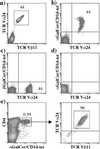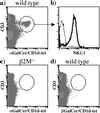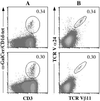Human CD1d-glycolipid tetramers generated by in vitro oxidative refolding chromatography
- PMID: 11248072
- PMCID: PMC30647
- DOI: 10.1073/pnas.051604498
Human CD1d-glycolipid tetramers generated by in vitro oxidative refolding chromatography
Abstract
CD1 molecules are specialized in presenting lipids to T lymphocytes, but identification and isolation of CD1-restricted lipid specific T cells has been hampered by the lack of reliable and sensitive techniques. We here report the construction of CD1d-glycolipid tetramers from fully denatured human CD1d molecules by using the technique of oxidative refolding chromatography. We demonstrate that chaperone- and foldase-assisted refolding of denatured CD1d molecules and beta(2)-microglobulin in the presence of synthetic lipids is a rapid method for the generation of functional and specific CD1d tetramers, which unlike previously published protocols ensures isolation of CD1d tetramers loaded with a single lipid species. The use of human CD1d-alpha-galactosylceramide tetramers for ex vivo staining of peripheral blood lymphocytes and intrahepatic T cells from patients with viral liver cirrhosis allowed for the first time simultaneous analysis of frequency and specificity of natural killer T cells in human clinical samples. Application of this protocol to other members of the CD1 family will provide powerful tools to investigate lipid-specific T cell immune responses in health and in disease.
Figures





Comment in
-
Right on target: novel approaches for the direct visualization of CD1-specific T cell responses.Proc Natl Acad Sci U S A. 2001 Mar 13;98(6):2950-2. doi: 10.1073/pnas.061032398. Proc Natl Acad Sci U S A. 2001. PMID: 11248010 Free PMC article. Review. No abstract available.
Similar articles
-
In vivo identification of glycolipid antigen-specific T cells using fluorescent CD1d tetramers.J Exp Med. 2000 Jun 5;191(11):1895-903. doi: 10.1084/jem.191.11.1895. J Exp Med. 2000. PMID: 10839805 Free PMC article.
-
Lipid antigen presentation in the immune system: lessons learned from CD1d knockout mice.Immunol Rev. 1999 Jun;169:31-44. doi: 10.1111/j.1600-065x.1999.tb01304.x. Immunol Rev. 1999. PMID: 10450506 Review.
-
Loading of the antigen-presenting protein CD1d with synthetic glycolipids.Chembiochem. 2004 Apr 2;5(4):437-44. doi: 10.1002/cbic.200300655. Chembiochem. 2004. PMID: 15185366
-
The complementarity determining region 2 of BV8S2 (V beta 8.2) contributes to antigen recognition by rat invariant NKT cell TCR.J Immunol. 2006 Jun 15;176(12):7447-55. doi: 10.4049/jimmunol.176.12.7447. J Immunol. 2006. PMID: 16751390
-
Generation of CD1 tetramers as a tool to monitor glycolipid-specific T cells.Philos Trans R Soc Lond B Biol Sci. 2003 May 29;358(1433):875-7. doi: 10.1098/rstb.2003.1267. Philos Trans R Soc Lond B Biol Sci. 2003. PMID: 12803920 Free PMC article. Review.
Cited by
-
Distinct functional lineages of human V(alpha)24 natural killer T cells.J Exp Med. 2002 Mar 4;195(5):637-41. doi: 10.1084/jem.20011908. J Exp Med. 2002. PMID: 11877486 Free PMC article.
-
Complementary approaches to study NKT cells in cancer.Methods Enzymol. 2020;631:371-389. doi: 10.1016/bs.mie.2019.08.010. Epub 2019 Oct 18. Methods Enzymol. 2020. PMID: 31948558 Free PMC article.
-
Roles for major histocompatibility complex glycosylation in immune function.Semin Immunopathol. 2012 May;34(3):425-41. doi: 10.1007/s00281-012-0309-9. Epub 2012 Mar 30. Semin Immunopathol. 2012. PMID: 22461020 Free PMC article. Review.
-
MHC class II-restricted interaction between thymocytes plays an essential role in the production of innate CD8+ T cells.J Immunol. 2011 May 15;186(10):5749-57. doi: 10.4049/jimmunol.1002825. Epub 2011 Apr 8. J Immunol. 2011. PMID: 21478404 Free PMC article.
-
Activation of human T cells by CD1 and self-lipids.Immunol Rev. 2015 Sep;267(1):16-29. doi: 10.1111/imr.12322. Immunol Rev. 2015. PMID: 26284469 Free PMC article. Review.
References
Publication types
MeSH terms
Substances
LinkOut - more resources
Full Text Sources
Other Literature Sources
Research Materials

